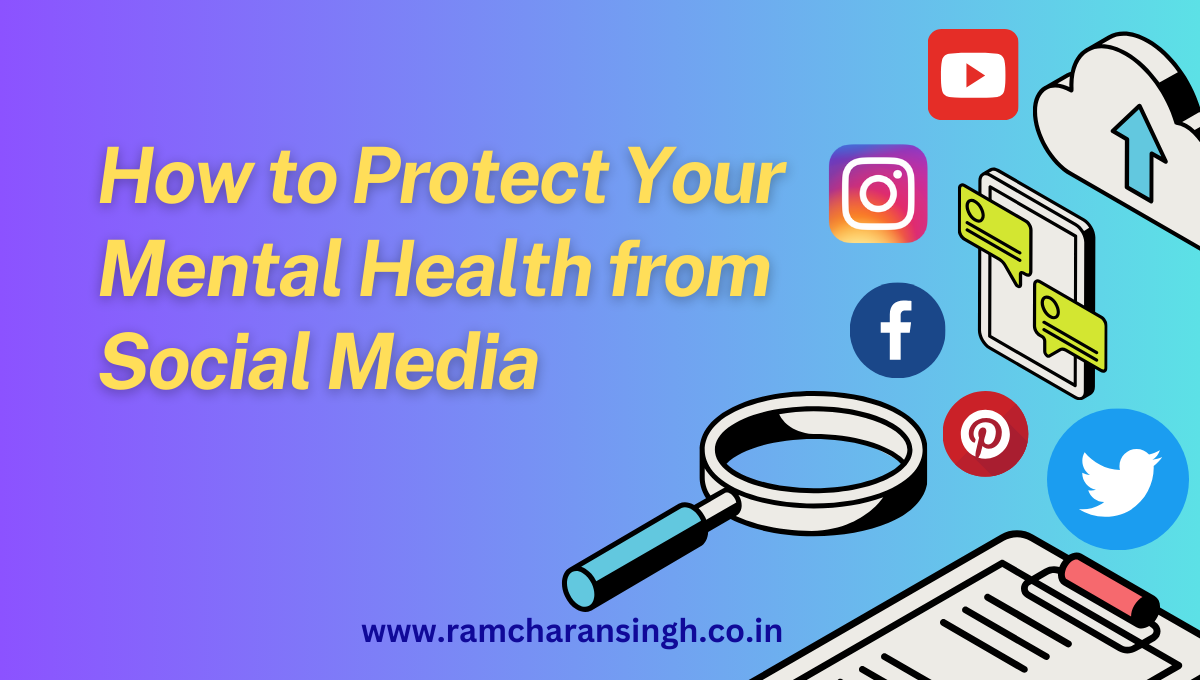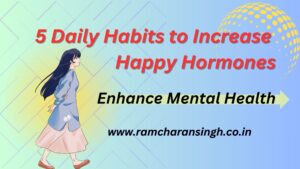In the digital age, social media has become a central part of everyday life. While it can be a source of entertainment, connection and information, it can also contribute to various mental health issues, including anxiety, depression and loneliness. The curated lives we see on our screens can lead to unrealistic comparisons, sleep disturbances, and a constant pressure to be ‘on’ and connected. However, by understanding “How to Protect Your Mental Health from Social Media,” it’s possible to maintain an active social media presence while also safeguarding your mental health. Here are seven tips to help you navigate the social media landscape with your well-being in mind.
1. Cultivate Awareness and Intentionality
Cultivating awareness and intentionality is a vital part of the journey when learning “How to Protect Your Mental Health from Social Media”. It’s not just about being aware of the time you spend on these platforms, but also about understanding the subtle ways in which they influence your emotions and thoughts. To truly cultivate this awareness, you need to become an observer of your own social media habits. This means taking note of which platforms you spend the most time on and what you’re typically doing during that time. Are you passively scrolling, actively engaging with content, or comparing your life to others? Awareness goes beyond just acknowledging these habits; it’s also about understanding the triggers that make you turn to social media in the first place. Are you seeking distraction, connection, validation, or entertainment?
Once you become more conscious of your usage and the emotions attached to it, you can begin to be more intentional with your interactions. This intentionality is about aligning your social media use with your core values and what truly matters to you. For instance, if learning is important to you, curate your feed to include educational pages and groups. If wellness is a priority, follow accounts that offer mental health tips and encourage healthy lifestyle choices.
Reflect on how you feel after interacting with certain types of content. Does a particular influencer or friend always leave you feeling negative? Or perhaps, some accounts consistently provide a sense of joy and inspiration. This reflection can guide you to make changes that enhance your experience. It’s also essential to identify the time of day when using social media feels most satisfying for you and when it does not. Some may find that morning scrolls help them wake up and feel connected, while for others, it might lead to a day starting with stress and comparison.
Setting intentional goals for your social media usage can provide structure and purpose. Goals can range from educational aspirations, such as learning a new skill through tutorial pages, to personal growth objectives, like supporting your hobbies by joining specific groups or following related accounts. Moreover, setting intentions can mean limiting exposure to content that doesn’t serve you. For example, if you notice that following news outlets is causing you stress, try to designate a particular time to catch up with current events, ensuring that you are getting this information from sources that prioritize factual reporting over sensationalism.
Intentional use also includes being conscious of the personal data you share and understanding the privacy settings on each platform. Take control over who can see your posts and personal information. Remember that not everything warrants public sharing and that keeping certain aspects of your life private can contribute to your sense of security and well-being.
In summary, cultivating awareness and intentionality about your social media use can significantly protect and improve your mental health. It requires an ongoing commitment to self-observation, reflection, and making conscious choices that support a balanced and fulfilling online experience. By doing this, you can enjoy the benefits of social media without allowing it to undermine your mental health.
2. Establish Boundaries and Limit Usage
Establishing boundaries and limiting usage is an essential strategy in the arsenal of “How to Protect Your Mental Health from Social Media”. The incessant flow of notifications and updates can easily make us feel like we need to be constantly available and responsive, but it’s important to remember that constant connectivity can lead to information overload, stress, and burnout.
One practical approach to establishing boundaries is to designate specific “social media-free” times throughout your day. These could be during meals, right after waking up, or the last hour before bed. By creating these small pockets of digital silence, you provide yourself with opportunities to engage in other activities that can boost your mental health, such as mindfulness, reading, or spending time with loved ones.
Technology itself can be a helpful ally in this endeavour. Many smartphones and digital devices now come with built-in features that monitor screen time and allow you to set limits for how long you can use certain apps each day. For instance, you might allocate a certain amount of time to social media platforms and once that limit is reached, the apps become inaccessible or send a reminder that it’s time to log off.
Another boundary to consider is the physical one. Keeping your phone out of the bedroom can reduce the temptation to scroll through social media before sleep, which can significantly improve sleep quality. Blue light emitted by screens can disrupt your circadian rhythm and suppress melatonin production, making it harder to fall asleep. Instead, develop a bedtime routine that prepares your mind and body for rest, free from digital distractions.
Moreover, during social media use, consciously ask yourself whether your current activity on the platform is intentional or habitual. By making a habit of this self-inquiry, you can better discern when you’re using social media as a tool for connection or falling into an autopilot scroll, which can often lead to wasted time and a negative impact on mental health.
In conclusion, setting boundaries around social media use isn’t about deprivation; it’s about creating a more balanced digital diet that allows for healthier consumption patterns. By limiting your usage and being mindful of when and how you engage with social media, you not only protect your mental health but also enhance your overall quality of life.
3. Curate Your Feed
Think of your social media feed like your own personal garden – you want it to be full of your favourite things and not overrun with stuff that makes you feel bad. So, it’s time to do some gardening!
Start by looking at the accounts you follow. Ask yourself, “Does seeing posts from this account make me happy or stressed?” If you notice that certain posts always seem to upset you or make you feel jealous or not good enough, it might be time to say goodbye to that account. It’s like pulling weeds; sometimes you need to get rid of the negative to make space for more positive things to grow.
But what if some of these accounts belong to friends or people you work with, and you feel like you can’t just unfollow them? That’s where the mute or hide button comes in. It’s like putting up a little fence in your garden. You’re not taking anything away, but you’re protecting yourself from seeing the stuff that brings you down. They won’t know you’ve muted them, and your feed will start to look a lot more like a place you want to be.
Now, for the fun part – adding the good stuff! Look for accounts that share content that makes you smile, laugh, or feel inspired. These could be pages that share beautiful pictures, funny videos, uplifting stories, or helpful tips about things you’re interested in. Each positive account is like planting a flower or a plant you love – the more you add, the more your garden will be a place of joy and peace.
Remember, you’re in control of your feed. You decide what you want to see every day. By curating your feed and making it a place that reflects the good stuff, you’re taking care of your mental health. Every time you scroll through your feed, you should feel like you’re walking through a beautiful garden that you’ve created – a place that makes you feel calm, happy, and inspired.
4. Engage Mindfully
Engaging mindfully on social media is about making sure that every action you take online is thoughtful and intentional. It’s easy to forget that behind every profile picture is a real person with feelings. So, every time you interact with someone online, whether it’s liking a post, commenting, or sharing, try to do it with the same care as if you were talking to them face-to-face.
Before you post anything, take a moment to think about why you’re sharing it. Is it because it made you laugh, and you want to spread a little joy? Is it something that amazed you, and you think others might find it amazing too? Or is it important to you that you’d like to discuss with your friends? By sharing things that are meaningful to you, you add value to the conversations happening on social media.
Now, what about comments? Sometimes, we see something online that we don’t agree with or that makes us feel an intense emotion. It’s important in these moments to take a breath before you hit ‘reply’. Think about what you want to say and ask yourself, “Is my comment helpful? Is it kind? Is it necessary?” This is where practising empathy comes into play. Try to understand where the other person is coming from, and remember that everyone has their struggles and stories that you might not know about.
The same goes for reacting to posts. If you see something that bothers you, you don’t always have to respond. It’s okay to scroll past content that doesn’t sit well with you. However, if you feel the need to respond, do it from a place of kindness. If you wouldn’t say it to someone’s face, it’s probably not worth saying online either.
It’s also good to remind yourself that it’s not just about how your words affect others. When you practice kindness and empathy online, it reflects on you and shapes how you see the world. It can make your social media space feel safer and more welcoming, not just for others, but for yourself too. This positive environment can have a huge impact on your mental health, making you feel more connected and less isolated.
In a nutshell, engaging mindfully means thinking before you act, treating others with respect, and remembering that your words have power. By doing so, you’re making social media a better place for everyone, including yourself.
5. Seek Authentic Connections
Social media gives us the ability to connect with people from all over the world, which is amazing, but sometimes these connections can lack the depth and fulfilment that real-world interactions provide. Seeking authentic connections means using social media not as an end, but as a means to enhance and deepen relationships with others in a more meaningful way.
To start building more authentic connections, look at your friends list. These are people you’ve probably met in different phases of your life—old school friends, former colleagues, family members, and so on. Instead of just liking their posts or dropping a casual comment, reach out to them with a personal message. Ask them how they’ve been, and what’s new in their lives, and share a bit about yourself too. This opens the door to a conversation that’s more personal than your typical online interaction.
When you see someone going through a tough time, or if you notice they’re celebrating a big win, consider giving them a call or arranging a video chat. Hearing someone’s voice or seeing their face can create a bond that texting can’t match. These actions show that you’re willing to invest your time in the relationship, which is the cornerstone of authentic connection.
Another way to use social media to foster genuine relationships is by engaging in online communities that share your interests. Whether it’s a book club, a fitness group, or a hobby-based community, these groups often arrange meetups or events. Participating in these events can help you meet new friends or deepen relationships with acquaintances.
Beyond individual relationships, look for opportunities to engage in meaningful discussions. Many social media platforms host live sessions or have discussion groups on a variety of topics. When you contribute to these discussions, share your thoughts honestly and respectfully. It’s in these exchanges of ideas that you can sometimes find the most unexpected and rewarding connections.
Remember, quality always trumps quantity when it comes to connections. It’s better to have fewer interactions that are rich and fulfilling than many that are shallow. By focusing on cultivating a smaller number of deeper relationships, you’re likely to feel more supported and less lonely. This approach aligns with our human need for connection and belonging, contributing positively to our mental health.
In summary, using social media as a bridge to real-world relationships can help you forge stronger bonds and feel more connected. It can counteract the sense of isolation that sometimes accompanies online-only interactions and contribute to a more satisfying social life. So the next time you log in, think of how you can turn those digital likes, comments, and shares into real-life moments and memories.
6. Take Regular Breaks
The constant stream of updates, notifications, and online interactions that come with social media can sometimes be overwhelming. Just like any other activity, it’s important to take regular breaks to recharge and reflect. This is where the idea of a social media sabbatical comes in – a dedicated period where you step away from all social media platforms to focus on yourself and the world around you.
The length of your break isn’t set in stone; it’s about what works for you. Some people find that staying off social media for a weekend gives them enough space to recharge, while others might opt for a week or even consider a month-long detox if they feel the need for a more substantial break.
During your time away from social media, you have the chance to rediscover and reconnect with other aspects of life that you enjoy. You might pick up a book that’s been gathering dust on your shelf, delve into a hobby that you haven’t had time for, or simply spend more time in nature. These activities not only offer enjoyment but also have a positive impact on your mental health. They can reduce stress, improve mood, and even boost creativity.
Moreover, engaging in these offline activities can provide a sense of accomplishment and fulfilment that’s often missing from the endless scroll of social media. Whether you’re completing a painting, mastering a new recipe, or finishing a challenging hike, these experiences can provide a rewarding counterbalance to the sometimes passive consumption of social media content.
Regular breaks also tackle the phenomenon of FOMO – the fear of missing out. FOMO can lead you to compulsively check social media so you don’t feel left out of the loop. However, by taking regular breaks, you can reset your relationship with social media and often realize that you’re not missing as much as you thought you would. This realization can be incredibly liberating and can help reduce anxiety associated with social media use.
During your break, you might also notice how your mood and overall well-being improve without the constant comparison and bombardment of information that comes with social media. This time away gives you the space to evaluate how you want to engage with these platforms when you return, if at all.
The idea of taking a break from social media also aligns with the concept of digital minimalism, which advocates for a more intentional use of technology, focusing on activities that directly add value to your life. By periodically pruning your digital habits, you’re not only protecting your mental health but also making room for more meaningful engagements, both online and offline.
In essence, regular breaks from social media aren’t about cutting out a part of your life; they’re about taking control of it. They’re an opportunity to pause, reflect, and ensure that when you do return to your feeds, you do so with a fresh perspective and a healthier mindset.
7. Practice Gratitude and Positivity
In the vast and varied landscape of social media, it’s easy to get caught up in the negatives—unrealistic standards, gloomy news, and the tendency to compare our lives with the highlight reels of others. However, by consciously choosing to focus on gratitude and positivity, you can transform your experience of these digital spaces.
Practising gratitude on social media starts with simple acknowledgements. You could post about things you’re grateful for, such as a sunny day, a good cup of coffee, or time spent with friends and family. When you share these moments, you’re not only reminding yourself of the good in your life but also inviting your followers to pause and consider the positives in their own lives. This practice can become a source of joy and reflection for both you and your audience.
Celebrate your successes and the successes of others as well. Did you reach a small goal or finally tackle that task you’ve been putting off? Share it! No victory is too small. When you open up about your achievements, you encourage others to share in your happiness, and this can create an atmosphere of support and motivation within your network.
Spreading positive messages can be another powerful practice. Share quotes that inspire you, stories that uplift you, and news that brings a smile to your face. When you do this, you’re not only curating a positive space for yourself but also for those who interact with your content. Positivity begets positivity, and as your network engages with these optimistic posts, social media algorithms take note and begin to show you more of the same. Before you know it, your feed becomes a source of inspiration rather than a drain on your emotions.
This positive shift can also influence how you interact with others on social media. Instead of scrolling past, take a moment to leave a kind comment, send a supportive message, or simply like a post. These small gestures can make a big difference in someone’s day and foster a kinder, more supportive online community.
Remember, social media platforms operate on complex algorithms that cater to engagement. The more you interact with positive and uplifting content, the more such content the algorithms will serve you. In a sense, you have the power to train the social media algorithms to feed you content that enhances your well-being rather than detracts from it.
Practising gratitude and positivity online is not just about creating a feel-good echo chamber; it’s about actively shaping your social media experience to be healthier and more supportive. By doing so, you become a beacon of positivity within your network, which can inspire others to do the same. This ripple effect has the potential to transform not just individual feeds, but the overall tenor of social media culture. It’s about making conscious choices that uplift and support, thus fostering an online environment where mental well-being is nurtured and encouraged.
Conclusion
In conclusion, while social media has its benefits, it’s vital to be aware of its potential impact on your mental health. By practising awareness and intentionality, establishing boundaries, curating your feed, engaging mindfully, seeking authentic connections, taking regular breaks, and fostering gratitude and positivity, you can enjoy the advantages of social media without letting it detrimentally affect your mental health. Remember, it’s not about disconnecting completely but about finding a balanced and healthy way to incorporate social media into your life.
Share this on .....




This blog seems like a great resource for anyone looking to improve their lifestyle. I appreciate the focus on diverse topics that cater to different interests. The idea of following on social media for updates is a smart way to stay connected. I wonder if there are any specific topics or themes that are covered more frequently? It would be interesting to know if there are any success stories or testimonials from readers. How do you decide which topics to focus on each month? I’m curious to hear more about the team behind the blog and their expertise. What’s the most popular post so far, and why do you think it resonated with the audience?